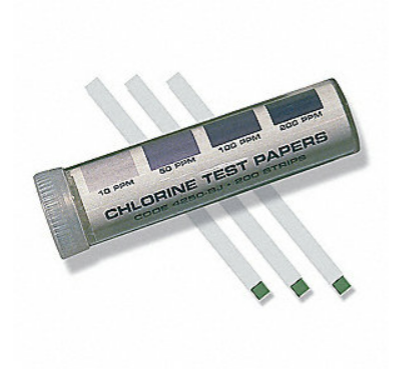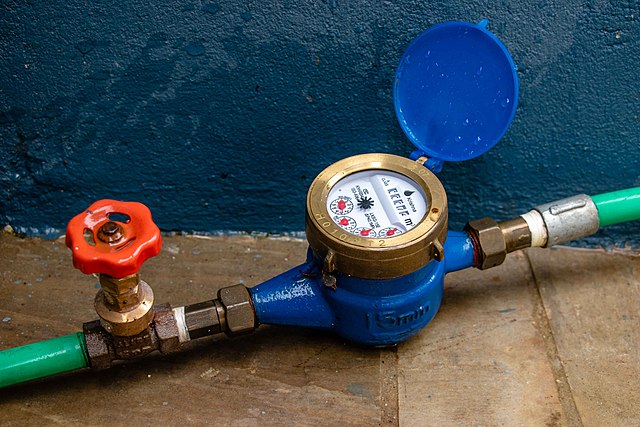Competency F2: Commission and Service Water Services and Distribution Systems
Learning Task 2
Describe the commissioning of water service and distribution systems
Commissioning a water service pipe and distribution system is the process of putting newly installed or repaired water pipes into service, making certain that it operates as intended, and the water is safe for consumption. After pipes have passed the static testing, commissioning proves they function properly under dynamic conditions along with the components connected to the distribution piping.
Pre-Check
Before commissioning a water service pipe, inspect the site for the necessary utilities and infrastructure such as water supply connections and shut offs, backflow prevention devices, and drainage systems. Inspect all piping materials, including pipes, valves, fittings, and connectors, confirm they meet the specified standards and are free from defects or damage. Check for proper labeling and certification markings on the materials and verify the piping passed the required pressure tests.
Hazards
When commissioning a water service pipe, there are several hazards that need to be addressed to work safely. Potential hazards include:
- Pressure hazards
- Chemical hazards
If the pipes have passed a static pressure test, a failure is unlikely, but that risk remains since the system will now be running and pressures will be fluctuating. When there is a risk of the pipe bursting, it can lead to property damage, personal injury, or flooding. If a pipe bursts or fails under pressure, there is a possibility of flying debris, such as fragments of the pipe or fittings, which can cause injuries.
Depending on the nature of the water being tested, there may also be chemical hazards present. For example, if the water contains high levels of chlorine, a pipe failure could result in a chemical spill endangering the health of individuals and the environment.
Safe Work Practices
To minimize hazards when commissioning, follow proper safety procedures by wearing appropriate PPE, such as safety goggles, gloves, and protective clothing, to protect against potential flying debris or chemical exposure. Follow manufacturer guidelines and recommended pressure limits for the pipes being tested. Conduct the testing in a controlled environment and be aware of any nearby objects or people that may be affected by a potential pipe failure. Have emergency procedures in place, such as an emergency shutdown plan, access to first aid kits, and knowledge of the location of emergency exits and safety showers/eyewash stations. Even try to keep a safe distance from the pipe being commissioned.
Chemical Treatment
Commissioning water service pipes includes confirming that the water is safe for drinking. Chemical treatment can be used to disinfect the water and maintain its quality. Some common methods of chemical treatment for potable water are:
- Chlorination
- Ozonation
- pH Adjustment
Chlorine is commonly used to disinfect water and kill harmful microorganisms, such as bacteria and viruses. It can be added to the water in the form of chlorine gas, liquid chlorine (sodium hypochlorite), or solid chlorine compounds (calcium hypochlorite). The dosage of chlorine is calculated to achieve effective disinfection without exceeding safe limits.
Ozone is a powerful oxidizing agent and disinfectant. It is effective in destroying bacteria, viruses, and organic contaminants. Ozone is typically produced using specialized ozone generators and injected into the water.
pH adjustment is necessary to optimize the effectiveness of disinfection and to control corrosion. The addition of acids or bases can be done to achieve the desired pH range for water disinfection and stability.
It is important to follow proper dosing guidelines and adhere to local regulations and standards when using chemicals for water treatment. Regular testing will be required to confirm that the chemical treatment is effective and the water remains safe for consumption.
Purging
Purging a water service piping involves removing unwanted substances from the pipe system to ensure proper water flow, prevent air pockets and remove contamination.
Air
Purging a pipe with air is an effective way to remove water or other fluids from a pipe or to clear out any obstructions. Air is compressed and introduced into the pipe with pressure and forces out liquids, debris, and sediment.
Chemical
Chemicals are often used to disinfect water to make it potable. New water service piping and pipes that have been drained for repair or replacement, must be purged with chlorine to replenish the required safe water drinking levels. Any addition of chemicals will require that it be measured and added in a safe manner and according to that jurisdiction’s code. Care should be taken to wear the proper PPE and testing the chemical levels will need to be arranged and performed before the piping is put back into service.
Test Water
If chemicals have been used to disinfect water intended for drinking, the water must be tested for the present levels and must not exceed the amounts laid out in codes like the Safe Drinking Water Act or the AHJ. As an example, to test the chlorine content in water, you can use a chlorine test kit or a chlorine test strip (Figure 3). These kits are available at pool supply stores, hardware stores, or online. Use a clean container to collect a sample of the water being tested. Make sure the container is free of any residues or contaminants that could affect the test results. Some test kits require mixing reagents to create a test solution, while others may have pre-filled reagent capsules or test strips. Prepare the solution as instructed. Dip the test strip into the water sample or add the test solution to the water sample, depending on the specific instructions. Make sure the strip is fully immersed or that the solution is thoroughly mixed with the sample. The test kit instructions will specify the required waiting time for accurate results. Avoid disturbing the strip or the solution during this waiting period. After the designated waiting time, compare the color of the test strip or the solution against a color chart provided with the test kit. The color change will indicate the chlorine content in the water sample. Note the chlorine concentration indicated by the test kit and record the results for future reference and to submit to the local authority.

Flushing
Flushing water piping helps remove debris, sediments, and stagnant water. Flushing a dead end is a large part of the regular maintenance procedures carried out in communities, but can be first performed during commissioning. If dead ends are not flushed, the stagnant water will lose its chlorination and potentially become unsafe for consumption.
Commissioning Equipment
Commissioning water service piping involves several pieces of equipment. The equipment used can vary depending on the size and complexity of the project and include:
- Pressure Gauges
- Flow Meters
- Pressure Testing Equipment
- Water Quality Testing Equipment
Pressure gauges are used to measure and monitor the pressure levels within the water service piping system. They help ensure that the pressure is within the required range and assist in detecting any anomalies or pressure drops that may indicate leaks or other issues.
Flow meters are employed to measure the rate of water flow through the piping system. They provide valuable, visual information about the water flow characteristics and assist in assessing the performance of the system.
Pressure testing equipment such as hydrostatic test pumps, pressure regulators, and pressure relief valves. These tools help apply and control the required pressure during testing and ensure that the piping system can withstand the expected operating conditions.
Water quality testing equipment is used to analyze and assess the chemical and physical properties of the water. This includes pH meters, turbidity meters, conductivity meters, and test kits for testing parameters like chlorine levels, hardness, or other specific contaminants.
Start-up
Permits
Permits may be required for commissioning water service piping. Permits are a commitment to adhere to certain authorities and their specific rules. These include compliance with building codes, calling for any mandatory inspections, hiring competent professionals, properly documenting jobs, and maintaining public safety.
Permits can be obtained through the building inspection office in the area. A fee and processing time will be needed before commissioning will be approved and can begin.
AHJ
Water service pipes must comply with specific regulatory standards to ensure water quality, health, and safety for consumers. Similar to obtaining permits, before working on water service lines, you will be required to contact the local authorities for permission and instruction. Rules will vary from one jurisdiction to another.
Electrical Supply Connections
Many of the components connected to the water supply and, therefore, the water service piping, require electricity to draw water, distribute water, and track the water being used. As part of the commissioning process, it is important to check those components.
Hot water tanks
Electric water heaters require a 240-volt dedicated circuit, which serves only the water heater and no other appliances or devices. On demand systems require a dedicated 120-volt circuit.
Water treatment equipment
Water treatment equipment, such as an UV lamp, require electricity to work and its electrical outlets should be tested as part of the commissioning process.
Pumps
Like the other equipment discussed above, pumps will usually have an electrical component that should be checked when commissioning. Pumps typically run using a 120-volt circuit.
Heat tracing
By providing controlled heat, heat tracing prevents freezing or maintains the required temperature in pipes, vessels, or equipment. It is commonly used in industries such as oil and gas, chemical processing, power generation, and water and wastewater treatment, where temperature control is critical for operational efficiency and safety. Heat tracing will also be found on pipes run in the crawl spaces of residences and must be energized before temperatures drop below freezing.
Water meters
Water meters are typically the responsibility of the local utility company. They can be visually checked to confirm functionality. As water passes through the meter, it will record the volume which will be accessible by a remotely read transmitter.

Codes and Regulations
AHJ
Maintain comprehensive documentation throughout the commissioning process. This includes recording test results, inspection reports, material certifications, and any deviations or modifications made during installation. Proper documentation is essential for compliance, future reference, and troubleshooting.
Manufacturer’s Documentation
Valves test
Important valves such as cross connection assembly check valves or pressure reducing valves should be tested for proper operation when commissioning a water service and distribution system.
Cross connection control assemblies
Cross connection control assemblies are required to be tested annually or when repairs or replacements are completed on the piping those assemblies protect. Only qualified personnel are authorized to test the assemblies. When commissioning a water system, make sure that all assemblies are up to date or re-tested as needed.
Pressure reducing valve (PRV) set points
A PRV works to maintain a set downstream pressure. Confirm it is installed in the appropriate location within the water supply system, downstream of the main water supply line and before any branching lines or fixtures that require reduced pressure. PRVs have an adjustable pressure setting. Using a wrench or pliers, adjust the pressure setting on the valve to the desired level. With the pressure reducing valve installed and adjusted, test the valve’s operation by slowly opening and closing the downstream water outlet or faucets. Observe how the valve responds to changes in flow and pressure. The valve should open and close smoothly, maintaining the desired pressure within the set range. Attach a pressure gauge to a downstream faucet or outlet to monitor the pressure. Gradually open the faucet and observe the pressure gauge. Ensure that the pressure remains within the desired range as set by the PRV. Make any necessary adjustments to the valve if the pressure deviates from the desired range. Inspect the pressure reducing valve and all connections for any signs of leaks. Ensure that all fittings are tight and secure. Address any leaks promptly by tightening connections or replacing faulty components. Keep a record of the commissioning process, including the pressure setting, any adjustments made, pressure readings, and any observations or notes regarding the valve’s performance. This documentation can be helpful for future reference, maintenance, and troubleshooting.
 Now complete Self-Test 2 and check your answers.
Now complete Self-Test 2 and check your answers.
Self-Test 2
Self-Test 2
Media Attributions
- Figure 3. “Chlorine test strips“ from Lamotte on Amazon is used for educational purposes under the basis of fair dealing.
- Figure 4. “Water meter“ by Bijay Chaurasia is licensed under a CC BY-SA 4.0 licence.

